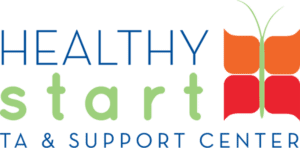Overview
Project Directors/Managers are responsible for ensuring that Healthy Start (HS) participants receive high-quality services, participants’ health and social service needs are met, and the HS benchmarks are achieved. To do so, projects must implement quality improvement policies and practices so they can monitor project performance and take corrective action, as needed.
Implementing Quality Improvement
HS projects work to reduce infant mortality rates and decrease disparities in infant mortality and poor perinatal health outcomes in their communities.
It takes time to show progress towards these goals. Quality Improvement (QI) results in measurable improvements in efficiency, effectiveness, performance, accountability, and outcomes in the short-term that lead to long-term outcomes.
QI:
- Starts with an understanding of the system
- Examines program components and processes rather than individuals
- Includes and encourages staff involvement and a team approach
- Is data driven
- Centers on the participant
- Is part of an ongoing process
Project Directors/Managers play a critical role in communicating the importance of QI and supporting HS staff to implement QI projects and sustain improvements over time. Dedicate time in your team’s workload to work on QI projects, ensure that the space and resources needed for this work are available, attend QI-related team meetings, and actively support indicated changes.
QI requires HS staff to identify problem areas, develop improvement strategies, and determine whether improvement has occurred. First, you must have a fundamental understanding of your HS project. This helps you identify your focus area, which can be very broad (e.g., prenatal care) or very specific (e.g., depression screening). An effective assessment tool will allow you to capture information about your project from many perspectives.
Approach QI as a team activity to foster ownership of both the improvement processes and adopted solutions. Each team member can play a different role:
- A QI lead to move the project forward and guide the team through the QI process. This can be the Project Director/Manager or someone else.
- A staff person with administrative or operational authority to make decisions when the team identifies changes
- Staff who are directly engaged in the processes you are trying to improve
- You may also choose to engage a HS participant.
QI is data-driven. Using data can help your team separate what you think is happening from what is really happening. Data helps to identify problems and opportunities for improvement, provides information about root causes of problems, and allows you to compare measures over time to tell you whether changes have actually resulted in improvements. Data can come from a variety of sources. While quantitative data provide hard numbers for measurement, qualitative data can help reveal why a problem occurs.
There are many QI approaches and models. The Model for Improvement adopted by the Institute for Health Care Improvement employs the following systematic process:
- Planning
- Trying out your plan
- Examining what happened
- Formulating next steps based on what you learned
QI starts with three basic questions:
- What is your team trying to accomplish?
- How will you know that you were successful?
- What changes can you make to get there?
Once you answer these three questions, you can start a Plan-Do-Study-Act (or PDSA) cycle. This includes:
- Design a plan to accomplish the desired improvement (based on data)
- Put it into action
- Collect data about your intervention, documenting what you learn along the way
- Examine the results of your trial (data)
- Determine how to move forward based on what the data show.
Ideas for improvement come from many sources, such as evidence-informed practices and guidelines, expert opinion, and brainstorming and creative thinking among staff members. Most changes will fall into one of three areas:
- Improving workflow
- Enhancing participant-staff relationships
- Standardizing processes that work well
Maintaining a focus on your services, keeping participants at the center, and tapping the knowledge of your staff will result in new ideas for improvement that ensure the quality of your program.
Small-scale changes are easier to manage. They allow your team to refine new processes, demonstrate their impact on practices and outcomes, and build support among partners. QI is an iterative process. Your team will likely make frequent corrections along the way as you learn from each step and identify other actions to take. Be prepared to refocus your aim. Any learning is forward progress–even if it is learning about what does not work!
Celebration is an essential component of performance improvement. QI is challenging work. When progress is incremental, as it often is with QI, your staff may feel it is accomplishing little. Take time to share and celebrate successes. This not only builds motivation among your team, but allows good ideas to spread to other settings.
